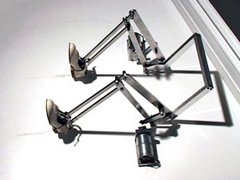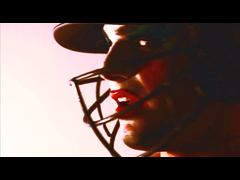
Video Works

Mara Battiste
Galatea's Golem
 Galatea's Golem revisits and revises two distinct historical alle gories at the origin of robotic art: the tale of Pygmalion, a sculptor who fell in love with Galatea, the statue he had carved and the story of the Golem, an animated anthropomorphic being created entirely from inanimate matter. Historically, masculine perspective has heavily dominated both robotics and the precursory folklore and mythology that came before. This film is meant to bring into question what innovative roles women can play in the contemporary and upcoming beliefs and practices of this hybrid field of art, industry, and culture.
Galatea's Golem revisits and revises two distinct historical alle gories at the origin of robotic art: the tale of Pygmalion, a sculptor who fell in love with Galatea, the statue he had carved and the story of the Golem, an animated anthropomorphic being created entirely from inanimate matter. Historically, masculine perspective has heavily dominated both robotics and the precursory folklore and mythology that came before. This film is meant to bring into question what innovative roles women can play in the contemporary and upcoming beliefs and practices of this hybrid field of art, industry, and culture.
True Companion
 After being introduced to True Companion LLC and the idea of Roxxy the sexbot "girlfriend," I compiled quite a long list of questions concerning the nature and connotations that come with this genre of robotics: what makes such a product appealing enough for a person to pay around 7,000 dollars for an artificial mate? Is it the desire for power and control over another being? Is it a real life fear of judgment or rejection? Or is it something else? This video is a mocumentary style parody of the product that companies like True Companion offer. The main character is a fem-bot who comes out of the box with a malfunctioning personality. Instead of providing agreeable, reinforcing conversation she is argumentative and difficult to get along with.
After being introduced to True Companion LLC and the idea of Roxxy the sexbot "girlfriend," I compiled quite a long list of questions concerning the nature and connotations that come with this genre of robotics: what makes such a product appealing enough for a person to pay around 7,000 dollars for an artificial mate? Is it the desire for power and control over another being? Is it a real life fear of judgment or rejection? Or is it something else? This video is a mocumentary style parody of the product that companies like True Companion offer. The main character is a fem-bot who comes out of the box with a malfunctioning personality. Instead of providing agreeable, reinforcing conversation she is argumentative and difficult to get along with.
Mara Battiste is an MFA student in the program of Electronic and Time-Based Art at Purdue University.
Ian Ingram
The Woodiest
 The Woodiest
is a robotic system that listens for the signature drumming of Pileated Woodpeckers in the forest. When it hears it, it responds by raising a male head and drumming back, simultaneously declaring its territory and indicating where it would like to build a nest. However, in this case, its mate is built-in: after retracting the male head, the machine raises its female head and drums in the exact same place. The decision process is thus simplified through the application of a hermaphroditic robotic system. Even though this work does not address the theme of humanoid robots directly it provides - through the use of both male and female features in animals and specifically the idea of hermaphroditic representation - a new way of looking at gender in humanoid robots as well: the idea of transgender representation, hermaphrodites and hybrids. This work provides a starting point for the discussion of alternative possibilities of representation in humanoid robots - beyond a simplistic male/female gender distinction.
The Woodiest
is a robotic system that listens for the signature drumming of Pileated Woodpeckers in the forest. When it hears it, it responds by raising a male head and drumming back, simultaneously declaring its territory and indicating where it would like to build a nest. However, in this case, its mate is built-in: after retracting the male head, the machine raises its female head and drums in the exact same place. The decision process is thus simplified through the application of a hermaphroditic robotic system. Even though this work does not address the theme of humanoid robots directly it provides - through the use of both male and female features in animals and specifically the idea of hermaphroditic representation - a new way of looking at gender in humanoid robots as well: the idea of transgender representation, hermaphrodites and hybrids. This work provides a starting point for the discussion of alternative possibilities of representation in humanoid robots - beyond a simplistic male/female gender distinction.
Ian Ingram
Ian Ingram is a Pittsburgh-based maker of behavioral objects. He has exhibited his work indoors and in the wild at various locations, including at the Andy Warhol Museum, Westinghouse Pond in Schenley Park, the Museum of Modern Art of Toluca, Mexico, the Skowhegan Cow Pastures in Maine, and in Popular Science Magazine. Ian has a BS and MS from the Massachusetts Institute of Technology and an MFA from Carnegie Mellon University. He is co-founder of the interdisciplinary art and robotics collective Rossum's.
Heidi Kumao
Misbehaving
 Misbehaving
is a series of three female "performers" for intimate installations. In each tableau, a hybrid machine "being" performs: a kinetic, electronically controlled machine speaks with a visual voice of erratic physical gestures and video imagery. As a combination of performance and robotics, they represent girls and women who disobey or resist expectations. Unlike machines designed for perfect job performance, these machines will declare their fallibility, impatience, approval, and disapproval through small gestural acts and embedded video sequences. In contrast to the precise technique and tireless efforts of a robot that plays chess or constructs automobiles, my robotic performers "act out" and misbehave. In these tableaus of protest and transformation, the machine is spirited, emotional, thoughtful, yet irregular.
Misbehaving
is a series of three female "performers" for intimate installations. In each tableau, a hybrid machine "being" performs: a kinetic, electronically controlled machine speaks with a visual voice of erratic physical gestures and video imagery. As a combination of performance and robotics, they represent girls and women who disobey or resist expectations. Unlike machines designed for perfect job performance, these machines will declare their fallibility, impatience, approval, and disapproval through small gestural acts and embedded video sequences. In contrast to the precise technique and tireless efforts of a robot that plays chess or constructs automobiles, my robotic performers "act out" and misbehave. In these tableaus of protest and transformation, the machine is spirited, emotional, thoughtful, yet irregular.
Heidi Kumao
Heidi Kumao is an interdisciplinary artist who creates video and machine art to explore ordinary social interactions and their psychological undercurrents. Emerging from the intersection of sculpture, theater and engineering, her "performative technologies" generate artistic spectacle in order to visualize the unseen: psychological states, emotions, compulsions, thinking patterns, and dreams. These works are designed to re-enact an event, perform a task for the viewer, or mediate her roles as a woman. Using a range of tools, she creates kinetic and electronic sculpture, interactive installations and digital animations. She is currently an Associate Professor in the School of Art and Design at the University of Michigan, Ann Arbor.
Debra Swack
My Perfect Child
 My perfect Child explores the history of engineering the perfect child through genetics, cloning, reproductive technology, and selective abortion and its origin in literature, psychology, anthropology and child-rearing manuals. The work contains paraphrased quotes from Designing Babies by reproductive expert Roger Gosden. Swack argues that there are real concerns that improving the quality of our young could be dangerously close to Eugenics. The author of Designing Babies acknowledges this but argues that little room for abuse exists if these decisions lie within the realm of individual couples. The problem, as explained by Swack, is that when Reproductive Technologies becomes more readily available there will be pressure to use it and those that do not (or who do not use it in the same way) may be discriminated against or perish. Additionally, it may be very expensive, so class divisions could develop between those who can afford to do it and those who cannot. Cloning could destroy the meaning of family as we know it. Who will be parent, child. What role will the clone/child play and what rights does it have?
My perfect Child explores the history of engineering the perfect child through genetics, cloning, reproductive technology, and selective abortion and its origin in literature, psychology, anthropology and child-rearing manuals. The work contains paraphrased quotes from Designing Babies by reproductive expert Roger Gosden. Swack argues that there are real concerns that improving the quality of our young could be dangerously close to Eugenics. The author of Designing Babies acknowledges this but argues that little room for abuse exists if these decisions lie within the realm of individual couples. The problem, as explained by Swack, is that when Reproductive Technologies becomes more readily available there will be pressure to use it and those that do not (or who do not use it in the same way) may be discriminated against or perish. Additionally, it may be very expensive, so class divisions could develop between those who can afford to do it and those who cannot. Cloning could destroy the meaning of family as we know it. Who will be parent, child. What role will the clone/child play and what rights does it have?
The Emotions - after Charles Darwin
 This video installation currently being developed in collaboration with with neuroscientists at the Brain Mind Institute in Switzerland, attempts to prove the universality of emotions by transcending cultural categorizations such as species, race, age and gender and instead relates emotions to their neurobiological origins and functions. It further suggests that once empirically known, that this information can be used to genetically or technologically alter human emotion(s) in individuals or groups to create new beings or new emotional interiors that better conform to culturally desirable behaviors. This of course raises bioethical questions about the future nature of life for humans and animals. Genetically emotionally or otherwise enhanced individuals could become the fashionable norm; synthetic biology could replace plastic surgery, with the further complication of not knowing where those genetic modifications will take them as individuals or us as a species.
Each of The Emotion's panels display close-up graphic, moving images of men, women and children of all ages and races, expressing a specific emotion such as happiness, sadness, fear or anger. The images will morph/blend to form a continuous stream of soundless images whose emotion will not be identified so as to allow the viewer the ability to form their own conclusion as to what emotion they feel is being expressed (which will also test the universality of emotions).
This video installation currently being developed in collaboration with with neuroscientists at the Brain Mind Institute in Switzerland, attempts to prove the universality of emotions by transcending cultural categorizations such as species, race, age and gender and instead relates emotions to their neurobiological origins and functions. It further suggests that once empirically known, that this information can be used to genetically or technologically alter human emotion(s) in individuals or groups to create new beings or new emotional interiors that better conform to culturally desirable behaviors. This of course raises bioethical questions about the future nature of life for humans and animals. Genetically emotionally or otherwise enhanced individuals could become the fashionable norm; synthetic biology could replace plastic surgery, with the further complication of not knowing where those genetic modifications will take them as individuals or us as a species.
Each of The Emotion's panels display close-up graphic, moving images of men, women and children of all ages and races, expressing a specific emotion such as happiness, sadness, fear or anger. The images will morph/blend to form a continuous stream of soundless images whose emotion will not be identified so as to allow the viewer the ability to form their own conclusion as to what emotion they feel is being expressed (which will also test the universality of emotions).
Debra Swack
Debra Swack works for the SUNY@Buffalo Research Foundation where she does software testing, technical writing and software user training. Her artwork has been presented at Soundlab, The University of California at Irvine, White Box Gallery, Eyebeam, Princeton University, The New Museum, The New York Hall of Science, The Banff Center for the Arts, The Arts and Genomics Center in Amsterdam and Vancouver, Xerox's Palo Alto Lab, Real Art Ways (Sol LeWitt Collection) and the Beecher Center for Arts and Technology. She is currently collaborating with Helen Fisher, an anthropologist and national bestselling New York Times notable books author on a 3D interactive animation using artificial intelligence about dating called My Perfect Mate.
James Woodward
South Pacific 2.0
 South Pacific 2.0
uses the iconic song lyric from the 1949 musical South Pacific as well as Moore's Law, which describes the exponential growth of the number of transistors possible on a single computer chip. The video fetishizes the familiar lyric, producing multiplying heads and lyrical jumbling and playing with ideas of what socially constructs "man" - manifested by an intermittently appearing football player which saturates and transforms the shape and color of the singing heads. Eventually, the singing heads transcend their human state, now exuding robotic and mechanical expressions as a consequence of their own technological reproduction. The video continues my investigation of themes of isolation, gender and identity through the use of documented, performative acts but unlike previous works it emphasizes the transmission and speed of the medium and questions how technology shapes the personal and and vice-versa.
South Pacific 2.0
uses the iconic song lyric from the 1949 musical South Pacific as well as Moore's Law, which describes the exponential growth of the number of transistors possible on a single computer chip. The video fetishizes the familiar lyric, producing multiplying heads and lyrical jumbling and playing with ideas of what socially constructs "man" - manifested by an intermittently appearing football player which saturates and transforms the shape and color of the singing heads. Eventually, the singing heads transcend their human state, now exuding robotic and mechanical expressions as a consequence of their own technological reproduction. The video continues my investigation of themes of isolation, gender and identity through the use of documented, performative acts but unlike previous works it emphasizes the transmission and speed of the medium and questions how technology shapes the personal and and vice-versa.
James Woodward
Culling imagery from popular media and cultural outlets ranging from celebrated athletes to tragic heroines, James Woodward creates haunting works that address evolving technologies within the natural environment, social taboos and hysteria, and states of isolation and otherness. Employing video, photography and collage, his works challenge cultural and social constructs by manipulating and disorienting familiar people, places and objects. James Woodward received his BFA from NYU in 2005 and has been included in exhibitions at the Reina Sofia, Madrid; The Queens Museum of Art, New York; The Maysles Institute, New York; Derek Eller Gallery, New York and Benrimon Contemporary, New York. His works have screened at the NADA Art Fair, Miami; Canada Gallery, New York and the AutoCenter, Berlin. He is included this Fall in the upcoming exhibition "New Media, Sex, and Culture in the 21st Century," at the Museum of New Art, Detroit.
back to menu




